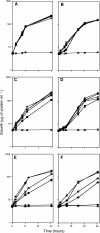argC Orthologs from Rhizobiales show diverse profiles of transcriptional efficiency and functionality in Sinorhizobium meliloti
- PMID: 21075924
- PMCID: PMC3019832
- DOI: 10.1128/JB.01010-10
argC Orthologs from Rhizobiales show diverse profiles of transcriptional efficiency and functionality in Sinorhizobium meliloti
Abstract
Several factors can influence ortholog replacement between closely related species. We evaluated the transcriptional expression and metabolic performance of ortholog substitution complementing a Sinorhizobium meliloti argC mutant with argC from Rhizobiales (Agrobacterium tumefaciens, Rhizobium etli, and Mesorhizobium loti). The argC gene is necessary for the synthesis of arginine, an amino acid that is central to protein and cellular metabolism. Strains were obtained carrying plasmids with argC orthologs expressed under the speB and argC (S. meliloti) and lac (Escherichia coli) promoters. Complementation analysis was assessed by growth, transcriptional activity, enzymatic activity, mRNA levels, specific detection of ArgC proteomic protein, and translational efficiency. The argC orthologs performed differently in each complementation, reflecting the diverse factors influencing gene expression and the ability of the ortholog product to function in a foreign metabolic background. Optimal complementation was directly related to sequence similarity with S. meliloti, and was inversely related to species signature, with M. loti argC showing the poorest performance, followed by R. etli and A. tumefaciens. Different copy numbers of genes and amounts of mRNA and protein were produced, even with genes transcribed from the same promoter, indicating that coding sequences play a role in the transcription and translation processes. These results provide relevant information for further genomic analyses and suggest that orthologous gene substitutions between closely related species are not completely functionally equivalent.
Figures




References
-
- Anisimova, M., and O. A. Gascuel. 2006. Approximate likelihood ratio test for branches: a fast, accurate and powerful alternative. Syst. Biol. 55:539-552. - PubMed
-
- Barrick, J. E., S. Y. Yu, S. H. Yoon, H. Jeong, T. K. Oh, D. Schneider, R. E. Lenski, and J. F. Kim. 2009. Genome evolution and adaptation in a long-term experiment with Escherichia coli. Nature 461:1243-1247. - PubMed
-
- Beaumont, H. J. E., J. Gallie, C. Kost, G. C. Ferguson, and P. B. Rainey. 2010. Experimental evolution of bet hedging. Nature 462:90-93. - PubMed
Publication types
MeSH terms
Substances
Associated data
- Actions
- Actions
- Actions
- Actions
- Actions
- Actions
- Actions
- Actions
- Actions
- Actions
- Actions
- Actions
- Actions
- Actions
- Actions
- Actions
- Actions
- Actions
- Actions
- Actions
- Actions
- Actions
- Actions
- Actions
- Actions
- Actions
- Actions
LinkOut - more resources
Full Text Sources

